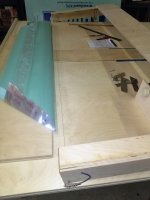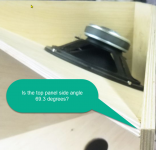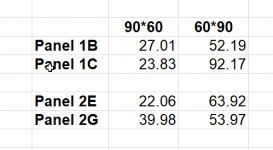fwiw, i would not make foamboard flares again. Too much work and expense. And hard to get right.
Ok I was thinking of doing this, but had to do some research on how to do it. I will just go with a simple round over for now. I have a big 3" round over router bit I can use. I was just thinking the bigger the round over the better...
Hi Mark/Bill, can you please confirm the top panel side angle? I must be doing it wrong, I thought I could flip the ThetaW=60 and ThetaH=90 (on Bill's synergy calc) so I could have it the same as Marks setup, where panel-1 is the enclosure and panel-2 is the triangular piece. When I do this the panel sizes are more than double.
Attachments
Hi Mark/Bill, can you please confirm the top panel side angle? I must be doing it wrong, I thought I could flip the ThetaW=60 and ThetaH=90 (on Bill's synergy calc) so I could have it the same as Marks setup, where panel-1 is the enclosure and panel-2 is the triangular piece. When I do this the panel sizes are more than double.
Yes, that's what I did ...flip horiz and vertical
So using 60 deg as horiz and 90 deg as vertical, piece 1 angle r = 69.3 deg.
Not sure what you mean by panel sizes are more than double though....
The pict you posted looks right... ???
Hi Mark/Bill, can you please confirm the top panel side angle? I must be doing it wrong, I thought I could flip the ThetaW=60 and ThetaH=90 (on Bill's synergy calc) so I could have it the same as Marks setup, where panel-1 is the enclosure and panel-2 is the triangular piece. When I do this the panel sizes are more than double.
That's really weird I sent Bill a pm recently with that very question!
You need to fiddle with the setting for 'lowest frequency at which horizontal pattern' to get it close (because horizontal pattern is now vertical if you flip it 90 degrees). In my case for a 60x40 (40 x 60) horn the lowest frequency ended up as 1011Hz for a 24" wide enclosure, but the depth etc ended up a bit different.
Rob.
That's really weird I sent Bill a pm recently with that very question!
You need to fiddle with the setting for 'lowest frequency at which horizontal pattern' to get it close (because horizontal pattern is now vertical if you flip it 90 degrees). In my case for a 60x40 (40 x 60) horn the lowest frequency ended up as 1011Hz for a 24" wide enclosure, but the depth etc ended up a bit different.
Rob.
Exactly Rob, just raise pattern control freq until you get the width you want.
If you want to see what freq that width controls, just switch H and V back to normal, and alter freq until you get back to same desired width.
Nice build you have going !
Thanks Mark,
I was just curious as to why the 40x60 version ended up being 3/4" different in depth.
I guess acoustically it really won't make any measureable difference.
I've decided to carry on with the mids mounted horizontally, I was worried about cone sag but there's not really much on the mids to sag
Rob.
I was just curious as to why the 40x60 version ended up being 3/4" different in depth.
I guess acoustically it really won't make any measureable difference.
I've decided to carry on with the mids mounted horizontally, I was worried about cone sag but there's not really much on the mids to sag
Rob.
Ouch sorry to hear that. Thanks for the warning Bill. I was going to try it with a band saw or a tracksaw. I'll play it safe and follow your suggestion.
Just to harp on this a little longer. The problem with slicing a pipe longways (metal, PVC, or otherwise) is that an extruded pipe has tremendous pressure in its walls which when you finally slice through will cause it to very suddenly clamp down hard on the saw blade like a pair of vice grips, and bad bad things happen. If you do need to slice a pipe with a table saw, a way to accomplish it (what I finally did way back when) is to drill some holes to bolt the pipe to a length of wood slightly thicker than the pipe diameter to ride the fence and to keep the pipe from rotating. Then slice into the pipe about 2/3rds of the pipe thickness on one side with a table saw - NOT ALL THE WAY THROUGH YET. Turn the pipe and board over and then slice through the on the other side. The first slice will reduce the pressure when the blade finally breaks through. A band saw that slices through two sides of the pipe at the same time might be ok, not sure, but you'll still probably still need to clamp the pipe to a board so you slice straight. With a track saw you'll need to do the partial slice on the opposite side trick or you'll have a saw or pipe or both flying away.
For what it's worth, I made horns with nice round PVC roundovers and with similar flat plywood 2nd expansions and can't say that I measured much difference at least none I could attribute to the change in horn width. Treble is largely constrained by walls nearer the throat, and as you get further out the horn the effect at HF will decrease. The wavelengths that will get most affected by the horn walls out further there will be larger than those at close-in (at 1kHz, a wavelength is over 1ft, unsmoothness that covers only a fraction of an inch of length isn't going to be do much there).
--
When I got hit by the kickback, it was several years before the damage showed up. It smashed a bile duct and gave me the same symptoms as colangiocarcinoma, a terrible form of cancer, which doctors operated on me for before finding it was a bile duct issue and not cancer -- I didn't realize until some years later that the nearly forgotten kickback was what started it all.
I doubt that's true. It will just make the effect happen at lower frequencies. If you made a big conical horn without a flare change and only use it down to frequencies above where the waistbanding happens, then it wouldn't be an issue. But that's kind of a waste of midrange directivity you fought hard for.I read here that the bigger the horn the less the second flare or round over helps?
That's because the spreadsheet only calculates off of horizontal directivity. If you make the closer-together walls (narrower angle) be the horizontal constraint, then the control frequency goes up pretty fast so you'd have to make a bigger horn for the same pattern control frequency in that direction to compensate. But the other direction (vertical, per the spreadsheet entry) then controls to lower than the frequency you entered. Just model with the further-apart walls as the horizontal to find the overall horn width you need, then swap horizontal and vertical and adjust the control frequency till you get the same overall horn width (in what now appears as vertical).Ok thanks, I didn't know I had to play with the pattern control.
I just kept everything the same and switch the ThetaW/H and got a way bigger horn...
fwiw, i would not make foamboard flares again. Too much work and expense. And hard to get right.
Just making a hot wire cutter that could handle a 4 ft span was enough work, then there was learning how to use epoxy and glass cloth.
Was a hell of a bigger project than the dang synergy itself.
Thanks for the report. I assumed it would be just cutting some foam board with an Xacto knife and attaching the pieces to the wood horn. Does that not work? I know it wouldn't be as rigid as something coated with fiberglass and epoxy (ungodly smelly stuff), but is there much vibration on the walls of a horn's second expansion at the frequencies where foamboard might resonate? I've read that Xrk has had good luck with horns made entirely foamboard.
By foamboard, I meant the laminate stuff like Gatorfoam Board not the sheets of styrofoam used for insulation.
If you do need to slice a pipe with a table saw, a way to accomplish it (what I finally did way back when) is to drill some holes to bolt the pipe to a length of wood slightly thicker than the pipe diameter to ride the fence and to keep the pipe from rotating. Then slice into the pipe about 2/3rds of the pipe thickness on one side with a table saw - NOT ALL THE WAY THROUGH YET. Turn the pipe and board over and then slice through the on the other side. The first slice will reduce the pressure when the blade finally breaks through. A band saw that slices through two sides of the pipe at the same time might be ok, not sure, but you'll still probably still need to clamp the pipe to a board so you slice straight. With a track saw you'll need to do the partial slice on the opposite side trick or you'll have a saw or pipe or both flying away.
Thanks a lot for the tips Bill. I'm not so sure now after hearing your story. I did experience a kickback before. I got hit mostly on the hip bone and stomach. I hurt like hell, didn't know it will have delayed/long term effects like you've experienced.
Ok I see it now, appreciate all help your Bill. Your spreadsheet does make all these builds simple. Thank youThat's because the spreadsheet only calculates off of horizontal directivity. If you make the closer-together walls (narrower angle) be the horizontal constraint, then the control frequency goes up pretty fast so you'd have to make a bigger horn for the same pattern control frequency in that direction to compensate. But the other direction (vertical, per the spreadsheet entry) then controls to lower than the frequency you entered. Just model with the further-apart walls as the horizontal to find the overall horn width you need, then swap horizontal and vertical and adjust the control frequency till you get the same overall horn width (in what now appears as vertical).
That's because the spreadsheet only calculates off of horizontal directivity. If you make the closer-together walls (narrower angle) be the horizontal constraint, then the control frequency goes up pretty fast so you'd have to make a bigger horn for the same pattern control frequency in that direction to compensate. But the other direction (vertical, per the spreadsheet entry) then controls to lower than the frequency you entered. Just model with the further-apart walls as the horizontal to find the overall horn width you need, then swap horizontal and vertical and adjust the control frequency till you get the same overall horn width (in what now appears as vertical).
That's what I did but I wondered why the depth changed by 3/4" ?
Cheers,
Rob.
Attachments
That's what I did but I wondered why the depth changed by 3/4" ?
Cheers,
Rob.
Same here, I matched the length and width, the depth is shorter by 0.774 inch.
Same here, I matched the length and width, the depth is shorter by 0.774 inch.
I don't know what's up with that (it's been years since I was into the spreadsheet). Maybe it was because the length is calculated for the horizontal frequency. The vertical behavior is basically a side effect of the horizontal values and vertical angle.
Thanks for the report. I assumed it would be just cutting some foam board with an Xacto knife and attaching the pieces to the wood horn. Does that not work? I know it wouldn't be as rigid as something coated with fiberglass and epoxy (ungodly smelly stuff), but is there much vibration on the walls of a horn's second expansion at the frequencies where foamboard might resonate? I've read that Xrk has had good luck with horns made entirely foamboard.
By foamboard, I meant the laminate stuff like Gatorfoam Board not the sheets of styrofoam used for insulation.
Aah, different foamboards. I've been using XPS from Lowes and Homedpot...particularly the 2" think stuff.
2" thick is the limit my tracksaw can cut vertically, and then a hotwire jig was used to cut the curvature....which was an important goal (kinda copying k402)

I can see the laminate stuff you are thinking about, maybe working nicely for straight secondary flares.
I don't know how stiff the secondary flare needs to be. It does give me pause for concern though.
My previous 60x40 with same overall mouth size as this 90x60 syn7, that I built entirely out of wood, sounds a little tighter in the low mid/ upper bass range.
I think there are 3 or 4 plausible causes:
the tighter pattern, way stronger mid-low drivers (way stronger!), the port location differences, and then finally...
does the foamboard soften the sound...??? plain dunno..
Ok understood, thanks Bill
Should be getting the guide rail for my tracksaw this week and start cutting the panels. Excited to get started on this...
Cool. I love my tracksaw soooo much. It's improved my speaker building skill greatly, compared to a pretty decent table saw with sliding Incra miter.
Makita, with both the 55" and 118" rails.
I hated paying for the 118" rail, but when it's needed, it really helps. Can hold 1/2mm true or better, over 8ft cuts with it...even with bevels.
I figure you know this, but for maybe others considering a tracksaw.....
best setup I've learned, is to put a 4x8 piece of ply on a couple of sawhorses, then on the ply put a 4x8 sheet of sacrificial XPS foam for blade to cut down into. Makes a great table for easy precision cuts...
- Status
- This old topic is closed. If you want to reopen this topic, contact a moderator using the "Report Post" button.
- Home
- Loudspeakers
- Multi-Way
- synergy.....Take #7


